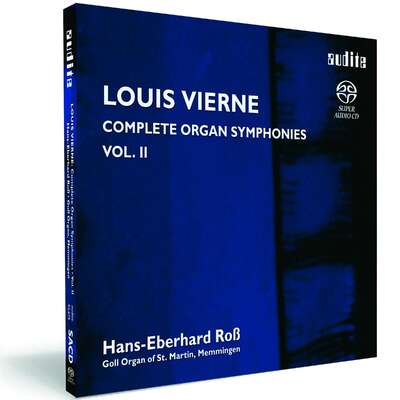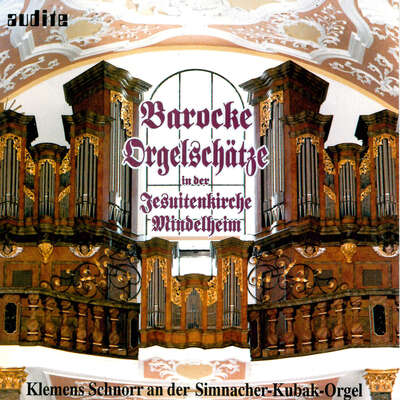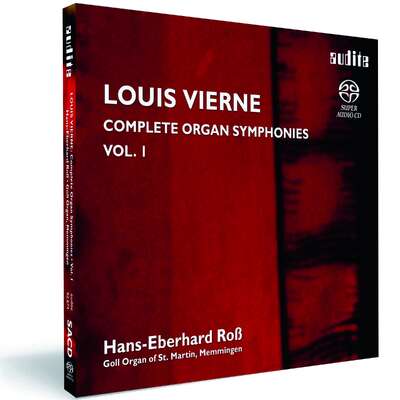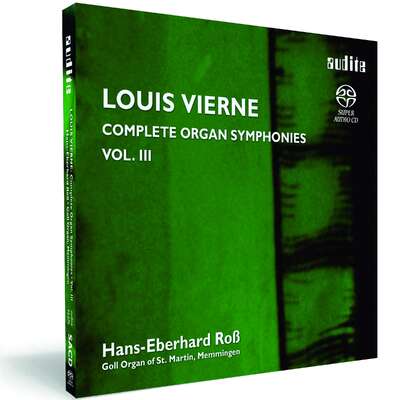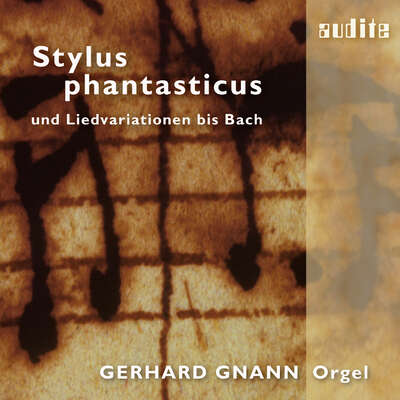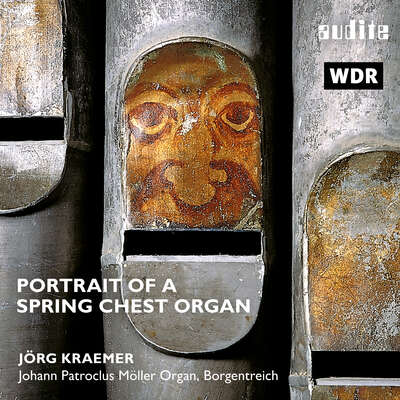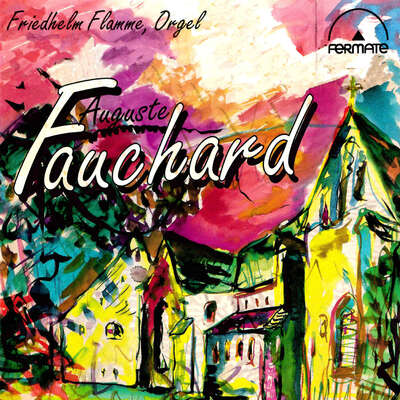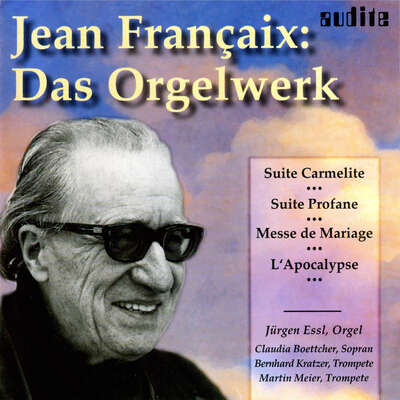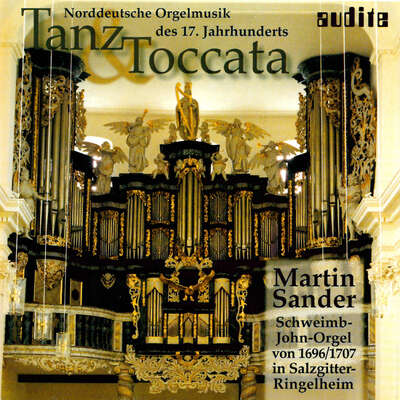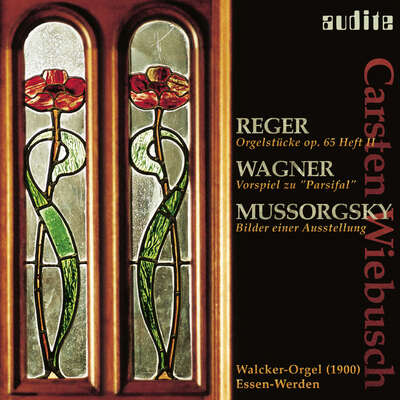
The present recording continues audite‘s three-part complete recording of Louis Vierne’s six Organ Symphonies that captivate the listener with their colouring and ever-growing mysticism. The sound of the renowned Goll Organ combines poetic lyricism with symphonic fullness and power. The ideal acoustics make it possible to clarify the polyphonic structures. The fresh tempi of the interpreter bring out concise rhythms that are capable of enthralling the listener in extraordinary ways.more
"An exciting release that embraces all the drama, quirkiness and transcendent beauty of Vierne's huge organ Symphonies. Ross's brilliant playing is captured in good sound." (BBC Music Magazine)
Details
|
Louis Vierne: Organ Symphonies op. 28 & op. 32
Complete Organ Symphonies • Vol. 2 |
|
| article number: | 92.675 |
|---|---|
| EAN barcode: | 4022143926753 |
| price group: | ACX |
| release date: | 30. August 2013 |
| total time: | 64 min. |
Bonus Material
-
Information about registration
Goll organ of St. Martin in Memmingen
Informationen
With the Third and Fourth Organ Symphonies, written in the years 1911 and 1914 respectively, the three-part complete recording of the six organ symphonies of Louis Vierne is being continued by audite. Recorded at the Goll organ of St. Martin in Memmingen, the recording is characterised by the warm, soft and widely mensurated sound of the organ. Its sound creates unobtrusive power and fullness, making a symphonic effect in the church interior of St. Martin and yet always remaining clear. The polyphonic structures of the works become distinct and the transparency of sound permits fresher tempi than usual - both of which cannot normally be taken for granted with recordings of Vierne. Louis Victor Jules Vierne was highly gifted and ambitious, but nearly blind. His reaction to virtuosic organ playing, such as that of César Franck, was marked by bliss and suffering, joy and fear. He studied in Paris with Charles-Marie Widor, who had founded the genre of the organ symphony. At the age of 23, a future full of hope stood before him. That was in 1894 - when the French composer, organist and instrumental pedagogue Louis Victor Jules Vierne was able to deputise for his teacher in a dual capacity: at the organ console of the Parisian Church of Saint-Sulpice and in Widor's organ class at the Conservatory. But Vierne's calling was for higher endeavours: between 1899 and 1930 he composed six organ symphonies that were to bring the genre to a hitherto unknown peak of richness in timbres, mysticism and cyclical architectonics. The Organ Symphonies Nos 3 and 4 were written when Vierne was permanently employed as organist of Notre-Dame in Paris and his life was headed towards international success - but was also being increasingly confronted with tragedy. Hans-Eberhard Roß is Director of Church Music in Memmingen. He has already made an internationally successful recording for audite of the complete organ works of César Franck. Additional information on the Goll organ and the registration is available at www.audite.de.
Reviews
Ars Organi | 65. Jhg. Heft 1 März 2017 | Martin Köhl | March 1, 2017
Die Kombination aus Textgenauigkeit, Überlegenheit und interpretatorischer Spiellaune beeindruckt hier ein weiteres Mal. [...] Die Gesamtaufnahme der Vierneschen Orgelsymphonik durch Hans-Eberhard Roß setzt Maßstäbe in mancherlei Hinsicht, denn sie ist sehr durchdacht, beruht auf überragendem technischem Können des Interpreten und beweist darüber hinaus, dass Cavaillé-Coll-Orgeln für die Darstellung dieses Œuvres durchaus kein Monopol besitzen.Mehr lesen
www.amazon.de | 2. Oktober 2016 | October 2, 2016 | source: https://www.amaz... Customer Review: Excellent Performance and Sound
Excellent interpretation and performance by organist Hans-Eberhard Roß. The super-audio sound is riveting and filled with clarity. The Goll OrganMehr lesen
Neue Musikzeitung | 7-8/15 (Juli-August 2015) | Hanspeter Krellmann | July 1, 2015
Die Rehabilitierung der vermeintlichen Orgel-Operette
Ein Streifzug durch die französische Orgelmusik des 19. Jahrhunderts anlässlich einiger CD-Neuerscheinungen
Roß' Gesamteinspielung der Vierne-Sinfonien ist bemerkenswert durch seine interpretatorische Herangehensweise an die sechs Stücke. [...] Roß lässt Viernes Sinfonien – vor allem die späten, also die Nummern vier bis sechs, die den Gipfelpunkt des sogenannten Impressionismus überschritten haben – sich an extremen Ausprägungen moderner Haltungen wie der Atonalität reiben, um ihnen eine angemessene Ausdrucksbreite abzugewinnen. So atmet die Musik einerseits, entzieht sich dem Ruch einer lediglich effektgesteuerten Wirkungsweise und richtet sich auf der anderen Seite entscheidend auf das Wechselverhältnis von Struktur und Ausdruck. Mehr lesen
Württembergische Blätter für Kirchenmusik | 6/2014 November / Dezember (81. Jahrgang) | November 1, 2014 Neue Tonträger
Hier liegt eine neue Aufnahme aller Orgelsymphonien Louis Viernes vor, dieMehr lesen
Audiophile Audition | August 11, 2014 | John Sunier | August 11, 2014
[...] these recordings, made by Audite in 2012, only used a 44.1K sampling rate (the same as standard CDs), but with a 24-bit word length instead of the usual 16-bit. This achieved a much improved sonic for the recordings, though not as good as a higher sampling rate might have. My personal preference for pipe organ recordings is a true binaural recording, heard via good headphones, but Audite’s multichannel surround is very good.Mehr lesen
American Record Guide | 18.03.2014 | William J Gatens | March 18, 2014
This is the second volume in a three-disc project to record the six organ symphonies of Louis Vierne (1870-1937). Hans-Eberhard Ross, since 1991Mehr lesen
At the beginning of his interpreter’s notes in the booklet Ross quotes Vierne to the effect that he had in mind the instrument and ambience of Notre Dame Cathedral in Paris for his organ compositions. Vierne was organist there from 1900 until he died. A few lines later, Ross is highly critical of recordings of Vierne on opulent Cavaille-Coll instruments in cathedrals with too much reverberation. Even if this contradicts the composer’s stated ideal, Ross does have a point. In Marie-Claire Alain’s 1989 recording of the first four Vierne symphonies at the Cavaille-Coll organ at St Stephen’s Abbey in Caen (Erato), to name but one example, a good deal of contrapuntal detail is inaudible in the overwhelming cloud of reverberation. What good is compositional detail if the listener can’t hear it? Ross’s mission is to rectify this in the present series of recordings, and not everyone will agree on whether he has managed that.
Donald Metz reviewed the first volume of this series (Audite 92674; March/April 2013) and remarked on Ross’s more clinical approach to the music in comparison with other recordings. Describing the present performances as clinical would be too severe. Ross achieves his aim of making nearly every detail of the music audible, and while his performances may not be quite heart-on-sleeve, I find them far from dispassionate or insensitive. The organ itself combines darkness with clarity in a room with a four-second reverberation that imparts warmth without obscuring the part writing. The instrument may not have the passionate character of Cavaille-Coll at his best, but it is not worlds removed from it. Ross also takes a somewhat free approach to registration in the interest of clarity, but generally reproduces the composer’s intended tone colors.
Diapason | N° 622 Mars 2014 | Paul de Louit | March 1, 2014
Un Vieme cuisiné comme on nous rôtirait magnifiquement une poularde pour l'enduire ensuite de marshmallow: le sublime y jouxte le débile. QuoiqueMehr lesen
Quid? Une Cantilène (de la Symphonie n° 3) et une Romance (de la n° 4) extatiques, parmi les plus belles de la discographie; des mouvements centraux (Scherzo et Menuet) jamais caricaturaux ni récréatifs, clefs de voûte d'une grande forme irréprochablement tenue. Un finale de l'Opus 28 pétaradant et caracolé, un peu vulgos façon O.K. Corral. Un Allegro de l'Opus 32 dont l'articulation implacable rend, pour une fois, l'écriture très convaincante. Ces beautés nous rapprocheraient de l'or ... Mais voilà: il y a aussi le finale de la Symphonie n° 4, haché menu comme chair à pâté, et surtout le Maestoso initial de la n° 3. Là, l'interprète s'est trompé de programme et nous balance, à la décrochez-moi-ça, une espèce de boléro de concert avec castagnettes et plumes dans le paf. Extravagance incompréhensible au regard du reste, et véritablement trop grotesque pour qu'on vous recommande ce disque sans un grain de très gros sel.
kirchmusik.de | 01.02.2014 | Rainer Goede | February 1, 2014
Diese deutsche Präzisions-Art der Interpretation hat aber auch viele Vorzüge, eben leichtere Durchhörbarkeit, Entschlackung der französischen Weihrauchkultur und eine ohrennahe Annäherung an die Strukturen der Symphonien und vor allem an das meist rasante Spiel des Interpreten. Roß gestaltet die Übergänge zwar z.T. sehr frei, nirgendwo allerdings ist sein Spiel manieriert oder gar ekstatisch übertrieben. Sein Ziel ist eine philologisch genaue, dabei musikantische Aufnahme, welches er mit Bravour auch erreicht. Die bayerische Landeskirche kann froh sein, einen solchen Organisten zu den ihren zu zählen!Mehr lesen
BBC Music Magazine | Christmas 2013 | JA | December 1, 2013
An exciting release that embraces all the drama, quirkiness and transcendent beauty of Vierne's huge organ Symphonies. Ross's brilliant playing isMehr lesen
International Record Review | December 2013 | Robert Matthew-Walker | December 1, 2013
The six organ symphonies of Louis Vieme naturally fall into the repertoire of such works by French composers, but they constitute a 'set' (albeit inMehr lesen
Of the six symphonies, only the first is in six movements – the others are all in five. In discussing the first volume of Hans-Eberhard Roß’s set in February 2013, I explained the multi-movement form of French organ symphonies, which I shall not repeat here, but what is remarkable in this sequence of extended works is the variety which Vierne brings to each multi-movement plan. He never 'repeats' himself in structuralization or emotional juxtaposition, and the result is – despite a certain macro-thematicism which tends to run throughout all six symphonies – that each work is quite different from its fellows, yet at the same time seems to 'belong' to the set.
It is a facet of large-scale integration of contrasts, which in my opinion has never received the musicological attention it deserves, but which these recordings in progress from this organist via Audite makes eminently worthwhile and practical.
Vierne was virtually sightless, and suffered greatly in his personal and professional life; the first element means that it is only quite recently that reliable editions of his works have appeared (he was considerably disadvantaged in checking proofs prior to publication and was often emotionally discouraged from dealing with practical matters). Although the symphonies were composed with the sounds of the great Cavaillé-Coll instrument at Notre-Dame very much in mind, the music in each symphony is sufficiently varied as to afford the performer with a number of choices, which in this case Roß explains in detail – at the same time as exhibiting his own love for and understanding of this music.
Thus it is that we have performances of these fine works which are compelling throughout. Particularly, the account of the great Adagio in the Third Symphony (arguably Vierne's masterpiece), shot through with deeply expressive invention, is very moving here, especially as the composer's individuality is strong and quite original, as we hear in the handful of recordings he made himself.
Roß’s accounts are consistently very good indeed: the main facet of his interpretative ability is that he brings out the character of each movement in both symphonies as well as relating them to the overall larger structure. This is a rare and noble quality, achieved through an integration of tempos as subtle use of registration – in the Third Symphony through relating the Adagio and the toccata-like finale, and in the Fourth (over which looms the shadow of the recently broken-out war) through thematic, cyclical, integration (César Franck was Vierne's teacher, albeit briefly) rather than emotional character (the variety in the first three movements is astonishing).
Apart from the committed intelligence of this fine player, the recording quality here is quite splendid, and this second volume deserves a strong recommendation to set alongside its predecessor.
Bayerischer Rundfunk | BR-KLASSIK, Leporello 21.10.2013 | Matthias Keller | October 21, 2013
Die Memminger Martinskirche [...] profitiert bei der halben Deckenhöhe im Vergleich zu Notre-Dame von einer erfreulich "präzisen" Akustik [...] Dazu ein Interpret, der sich bereits mit seiner César-Franck-Gesamteinspielung als Experte dieses Genres ausgewiesen hat, und der sich durchaus die Freiheit nimmt, hier und da das bekannte Einheits-Legato zu verlassen zugunsten schärferer Konturierungen. All das sorgt für eine Vierne-Gesamtedition unter "Laborbedingungen", was in diesem Fall nur positiv gemeint ist. Die hervorragende Aufnahmetechnik mit Surround-Option tut ein Übriges.Mehr lesen
Infodad.com | October 17, 2013 | October 17, 2013 Organic Growth
Hans-Eberhard Roß is doing a splendid job with these large-scale, broadly conceived and emotionally complex pieces. Roß plays the recently completed Goll Organ of St. Martin, Memmingen, which is a particularly felicitous choice for these Vierne works: its fullness and power are nicely complemented by delicacy and lyricism, providing the tremendous sonic and emotional range that these pieces require. And the polyphony of the music comes through clearly, thanks to the fine acoustics.Mehr lesen
Der neue Merker | 01.09.2013 | DZ | September 1, 2013 CDs, die noch auf meinem Schreibtisch lagen
Hans-Herbert Roß hat nach seiner ersten Vierne-CD (Symph. 1 + 2) nun denMehr lesen
Musik und Kirche | Mai/Juni 2014 | Martin Weyer Authentisch unauthentisch
Jenseits der Neidgrenze: Vor wenigen Jahren hat Kollege Roß an seinerMehr lesen
KULTUR - Zeitschrift für Kultur und Gesellschaft | Nr. 288 Freitag, 13. Dezember 2013 | wt Orgelsinfonien aus Frankreich
Hans-Eberhard Roß, der Memminger Kirchenmusikdirektor, hat seinen Zyklus aller sechs Orgelsinfonien von Louis Vierne (1870 – 1937) fortgesetzt. NunMehr lesen
Musica Sacra | 01.02.2014 | Rainer Goede
Diese deutsche Präzisions-Art der Interpretation hat aber auch viele Vorzüge, eben leichtere Durchhörbarkeit, Entschlackung der französischen Weihrauchkultur und eine ohrennahe Annäherung an die Strukturen der Symphonien und vor allem an das meist rasante Spiel des Interpreten. Mehr lesen

